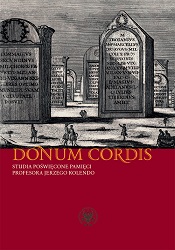Wojny dackie Trajana a napływ denarów rzymskich na tereny położone na północ od Karpat
Trajan’s Dacian Wars and the infl ow of Roman denarii into the areas located north of the Carpathians
Author(s): Arkadiusz Dymowski
Subject(s): Archaeology
Published by: Wydawnictwa Uniwersytetu Warszawskiego
Keywords: Jerzy Kolendo; archaeology; Poland; Europe; University of Warsaw; Polish Academy of Sciences
Summary/Abstract: Professor Jerzy Kolendo pointed out the possibility that the infl ow of Roman imports into the territories ofsouth-east Poland and west Ukraine could have been related to the people living there taking part in the DacianWars. It is worth verifying whether it would be possible to support this thesis by using the available data on thefi nds of Roman coins, specifi cally denarii, from the territories of south and central Poland, occupied in the Romanperiod by the Przeworsk culture, identifi ed with the Lugii tribes. In the territories which are of interest here, onecan clearly distinguish two barely intersecting groups of denarii fi nds: fi rstly, coins from the Republican period,secondly, imperial coins from the 1st–2nd century. These groups can be identifi ed with the two most importantwaves of the infl ux of denarii into the territories of the Przeworsk culture.Taking into account the coin fi nds recorded so far, it is impossible to present any evidence that would provethat the infl ux of Roman denarii into the territories north of the Carpathians was related to Trajan’s Dacian Wars.It would only be possible to present traces based on which one could try to very hypothetically outline this phenomenon,if it existed at all. During the period of the Dacian Wars denarii could have travelled north in two waves:fi rstly, Republican coins with a mix of imitations and coins from the issues of the fi rst three emperors, secondly,coins from Trajan’s issues, perhaps with a small amount of earlier coins mixed in. The fi rst wave could haveoriginated in the money circulating in the area of pre-Roman Dacia, the second one – in the imperial treasury. Inthe second case, these could have been payments made to the Lugii, related to military activities (e.g. wages formercenaries) or diplomatic ones (e.g. tributes, subsidies) paid out by the Romans in newly issued coins.
Book: Donum cordis. Studia poświęcone pamięci Profesora Jerzego Kolendo
- Page Range: 103-110
- Page Count: 7
- Publication Year: 2019
- Language: English, Polish, German
- Content File-PDF

